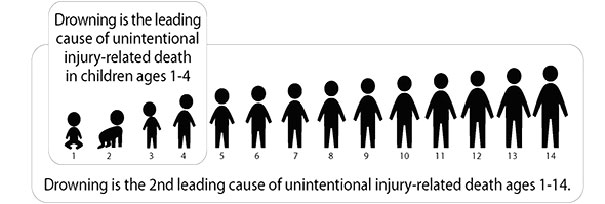
You’ve probably seen it before: parents at the pool chatting with friends who turn their back for a few seconds, when suddenly, a child is gasping for help. Instinctively, mothers and fathers will often dive in or immediately pull their child from the pool, often causing such a commotion that the child is more scared than it realized and ultimately, left with a bad feeling about the water.
Swimming Class Myths
It is a popular myth that by placing children in swimming classes, parents will feel a false sense of security and not pay as careful attention as if they were in the water with someone who could not swim. This leads many parents to draw the conclusion that swimming lessons to do not prevent drowning and may even promote it.
Thankfully, this is false. In fact, groups such as the American Academy of Pediatrics (AAP), who once concluded that children under certain ages weren’t developmentally ready for swimming lessons, have now reversed this opinion and have concluded that swimming lessons can help to increase water safety awareness and prevent drowning.
According to a 2009 study conducted by the Eunice Kennedy Shriver National Institute of Child Heath and Human Development, children who participate in formal swimming lessons are less likely to drown. The study found that among 61 children ages 1—4 who had died from drowning, only three percent had ever taken formal swimming lessons. By contrast, 26 percent of the children in the general population had received some type of formal lessons. In addition, parent interviews reflected that only five percent of the swimmers who drowned could float on their back for 10 seconds, while 18 percent of those who didn’t drown could float for at least 10 seconds.
What does all this mean? Teaching your child to swim will do a number of things, most importantly, keep them alive and safe. Swimming lessons will:
Educate children about water safety
1) Swimming lessons are designed to do more than teach stroke or breathing techniques. They also teach the importance of swimming with a buddy or parent, understanding when it’s safe to enter the water and identifying risks around the pool deck.
2) Teach them to be familiar and comfortable in both deep and shallow water. Drownings often occur when a child isn’t comfortable in water and hyperventilates or goes into panic mode. This results in swallowing water and getting tired more easily. Swimming lessons can provide simple ways for kids to retain their energy, such as floating on their back if out in a lake far from shore, treading water or even just standing up if in a shallow pool.
3) Show them how to recognize when others are in need. Advanced swimmers and even younger ones can often identify when someone is in trouble and notify an adult when a child is panicking.
The thought of drowning is scary to everyone; however, teaching your child to swim from an early age will enhance their knowledge and ability and ultimately help you enjoy the warmer months a little longer. Remember, Little Otter swimming lessons cater to the ages and ability of the swimmer. Safety is always a priority yet this does not mean that parental supervision will be unnecessary. We can never be “drownproof”, but we can always be safer around the water. It should always be a part of any time we are around water. But knowing your son or daughter can swim will ease any play day in the water.


Conversations